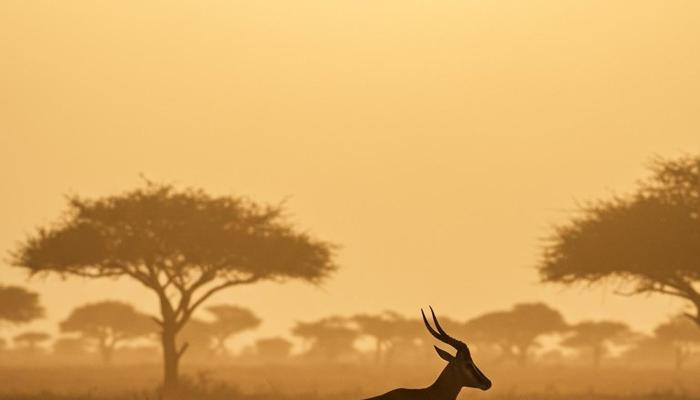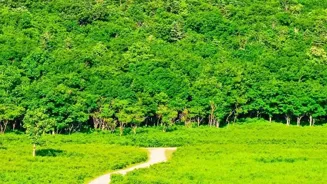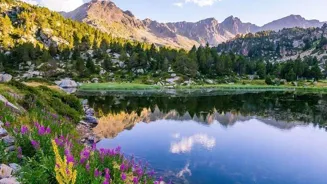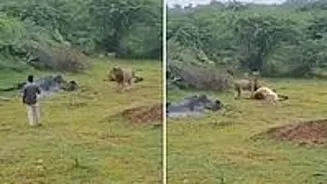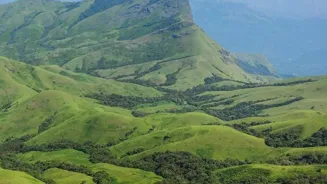Discover the remarkable Indian Desert Tortoise: a true survivor in the Thar Desert. Explore its 10 key traits for adaptation. Read on to learn how this tortoise thrives in a harsh environment
The Thar Desert,
a vast expanse of sand and scrub in western India, is home to a creature of remarkable resilience: the Indian Desert Tortoise ( Indotestudo elongata). Unlike its marine cousins, this tortoise has evolved in creative ways to survive the desert's harsh conditions.
They have to cope with heat, scarcity of water, and limited food resources. Let's explore the ten key traits that make this tortoise a true survivor. Their shell provides protection but also acts as a portable microclimate, safeguarding them from the harsh elements.
The tortoise’s ability to adapt ensures its survival in this unforgiving environment.
Indian Desert Tortoise's special skin prevents dehydration in desert heat
Firstly, special skin helps them a lot. The Indian Desert Tortoise has a thick, dry skin. This minimizes water loss through their skin. The skin has scales, which also helps to protect tortoise from the sun. This is particularly important in the desert heat, where evaporation leads to dehydration.
The tortoise's skin reflects sunlight, further reducing the amount of heat absorbed. This natural adaptation ensures they can stay hydrated for longer periods. Skin texture plays a key role in maintaining their well-being in arid conditions.
Indian Desert Tortoise conserves water to survive in desert
Secondly, the Indian Desert Tortoise conserves water within. They have developed efficient kidneys that minimize water loss through urination. They produce concentrated uric acid waste, which requires very little water to excrete.
This is a crucial trait for surviving during extended dry periods when the availability of water is very limited. This internal mechanism allows them to thrive in the desert environment. The tortoise has to be waterwise to survive there.
Tortoises conserve water by staying in burrows
Thirdly, their behavior saves lots of water. These tortoises spend much of their time in burrows. This is particularly during the hottest parts of the day. Burrows maintain a cooler, more humid environment than the surface, which is why the tortoise likes being inside.
The reduced temperature slows their metabolism and conserves water and energy. This behavior is essential for avoiding heat stress and dehydration. By staying in burrows, they control their body temperature.
Desert tortoises thrive on water-rich plants for hydration
Fourthly, the diet has to be something really good to survive. Desert tortoises consume succulents and drought-resistant plants. These food items have a high water content. This helps them stay hydrated. They can also get moisture from consuming dew and rainwater that collects on plants.
Their feeding habits are tailored according to the available plant life. This helps provide the nutrients needed for survival. The tortoise chooses food that serves their hydration needs.
Indian Desert Tortoise's unique nasal passages conserve water
Fifthly, there are special nasal passages that are helpful. The Indian Desert Tortoise has unique nasal passages. These passages help to extract moisture from the air they exhale. This amazing ability helps to reduce respiratory water loss. Their nasal passages act like little water traps.
This allows them to recycle the moisture and maintain water balance. This is a unique adaptation that is not common in all tortoise species. The nasal passages are crucial for water conservation.
Indian Desert Tortoise expert in heat tolerance, active in extreme temps
Sixthly, they are experts in heat tolerance. The Indian Desert Tortoise has a high tolerance for elevated body temperatures. This allows them to remain active during hotter times of the year. Their ability to withstand high temperatures helps them to forage and move around.
Without getting severely overheated is essential. This adaptability allows them to exploit the available resources. Even in the harshest conditions. The tortoise can handle heat that would be overwhelming to most.
Indian Desert Tortoises adapt activity to seasons, peak in monsoon
Seventh, they use seasonal activity. Indian Desert Tortoises exhibit a seasonal activity patterns. They are most active during the monsoon. This is when food and water are most abundant. During the dry season, they reduce their activity.
They also estivate in burrows to conserve energy and avoid harsh conditions. These tortoises align their behavior with the changing seasons. The tortoise uses the monsoon season to its advantage.
Good energy storage crucial for survival during scarcity
Eighth, good energy storage is useful. They store reserves of fat. This is particularly during the monsoon season. This provides them with energy during the dry spells, when food is scarce. The fat reserves help them to survive for a long time without food.
The stored energy ensures that they can endure periods of starvation without severe consequences. The ability to store energy is important for maintaining body balance.
Tortoises thrive in deserts with high salt tolerance
Ninth, they have high salt tolerance. These tortoises can tolerate higher salt concentrations in their diets and body fluids. This is important because desert plants often accumulate salts. The tortoise's salt tolerance allows them to consume a wide variety of desert vegetation.
The ability to handle higher salt levels is a unique trait. This is what helps them to thrive in saline environments. The tortoise's body is adapted to process desert plants.
Indian Desert Tortoises conserve energy with slow metabolism
Tenth, they have the ability to move and walk around. Indian Desert Tortoises show a lower metabolic rate compared to tortoises in temperate environments. Which means they don't get tired easily. This allows them to conserve energy and survive for extended periods.
This is especially when resources are limited. Their slow metabolism helps them to make the most. The body needs very little energy to carry on.
Indian Desert Tortoise adapts to survive in harsh Thar Desert
In conclusion, the Indian Desert Tortoise has a group of special features. It can survive in the really hot Thar Desert. These traits allow them to conserve water with special skin. They use their behavior to save energy when resources are limited.
These amazing traits allows them to live for a very long time because of this. The tortoise shows the power of nature's design. It adapts to survive in a tough place.
AI Generated Content. Glance/InMobi shall have no liability for the content
